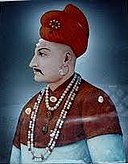Bhat family
| Peshwa Family (Bhat family) | |
|---|---|
| Current region | Sawai Madhava Rao II Narayan Baji Rao II |
The Bhat Peshwa family earlier known as Bhat family is a prominent Indian
Family tree
First generation
- Chitpavan Brahmin family[1][2][3] who gained effective control of the Maratha Empire during the 18th century. Balaji Vishwanath assisted a young Maratha Emperor Shahu I, grandson of Shivaji, to consolidate his grip on a kingdom that had been racked by civil war and persistent attack by the Mughals under Aurangzeb. He was called "the second founder of the Maratha State."[4]
Second generation

Balaji married Radhabai Barve (1685–1752) and had two sons and two daughters.
- to distinguish him from his grandson and namesake, Bajirao II, the last Peshwa.
- Bhiubai – She married Abaji Joshi of Baramati, brother of the banker Balaji Naik famed as Bajirao I's "most tormenting creditor", who belongs to Deshastha Brahmin community.[7]
- Anubai – she married Venkatrao Ghorpade of Ichalkaranji.[8] Their heirs ruled the state of Ichalkaranji until 1947.[citation needed]
Third generation


|Bajirao was married to Kashibai Chaskar Joshi, and had two sons together: Balaji Bajirao Peshwa (Nanasaheb) who was later appointed Peshwa by Shahu in 1740. Their second son was named Raghunathrao. Bajirao also took Mastani as the second wife who was the daughter of Maharaja Chhatrasal of Panna by a Persian Muslim wife. Chimajiappa was married to Rakhmabai (Pethe family). He had only son, Sadashivrao known popularly as Sadashivrao Bhau who led the Maratha forces in the Third Battle of Panipat against
- Battle of Panipat (1761).[citation needed]
- Raghunathrao (b. 18 Aug.1734 – d. 11 Dec.1783) was Peshwa of the Maratha Empire from 1773 to 1774. Earlier in his career as a commander of Maratha forces, he is credited with expanding the Maratha Kingdom to include far-flung areas such as Attock in present-day Pakistan.[9] However, he is also blamed sowing the seeds for the downfall of the Peshwa Dynasty. He is nicknamed as Ragho Bharari since he is instrumental in planting the triumphant Hindu Maratha flag till Attock in present-day Pakistan.[10]
- Sadashivrao Bhau (4 August 1730 – 14 January 1761) was the son of Chimaji Appa and Rakhmabai and the nephew of Peshwa Baji Rao I. He served as the Sarsenapati (commander-in-chief) of the Maratha army at the third battle of Panipat. He died fighting at the third battle of Panipat.[14]
- Janardan Rao who died young[citation needed]
Fourth generation
Sadashivrao Bhau's first wife's name was Umabai. She gave birth to two sons who died as soon. Umabai died in 1750. His second wife was Parvatibai. She accompanied Sadashivrao bhau during the battle of Panipat.
- Vishwasrao (7 March 1741 – 14 January 1761) was the eldest son of Balaji Baji Rao, Peshwa of Pune (Poona) (the prime minister and de facto ruler/administrator) of the Maratha Empire and also was the heir to the title of Peshwa of Maratha Empire. He was killed during the period of the most intense fighting (Approx. between 01pm and 02:30pm) at Third Battle of Panipat, fighting on the front lines. It is generally accepted that the third battle of Panipat, which hung in balance till his death, moved decisively in favour of the Afghans and ended up in victory of Durrani Empire.[citation needed]
- Madhavrao I (or Pradhanpant Shrimant Madhavrao (Ballal) Peshwa I a.k.a. Thorle Madhav Rao Peshwa ) (14 February 1745 – 18 November 1772) was the fourth Peshwa of the Maratha Empire. During his tenure, Maratha power recovered from the losses suffered during the Panipat Campaign, a phenomenon known as "Maratha Resurrection". He is considered one of the greatest personalities of the Maratha history.[citation needed]
- Narayan Rao (10 August 1755 – 30 August 1773) was the fifth Peshwa or ruler of the Maratha Empire from November 1772 until his murder by his palace guards in August 1773[15][16]
- Baji Rao II (10 January 1775 – 28 January 1851), also Rao Pandit Pandham, was the son of Peshwa Raghunathrao and Anandibai was Peshwa of the Maratha Empire, and governed from 1796 to 1818.He was installed as the Peshwa after his nephew, Sawai Madhavrao died without leaving an heir.
- Shamsher Bahadur I (Krishna Rao) and the grandson of Bajirao I[17] Under the auspices of the powerful Maratha nobles, Ali Bahadur established his authority over large parts of Bundelkhand and became the Nawab of Banda .Ali Bahadur supported Pune polity and fought the English in the Anglo-Maratha War of 1803[17][18]
Fifth generation
- Madhavrao II (18 April 1774 – 27 October 1795) Madhavrao II or Sawai Madhavrao was the posthumous son of the murdered Narayanrao and his wife Gangabai (née Sathe).He was proclaimed Peshwa as soon as he was born with a regency council called Barbhai mandal under Nana Fadnavis ruling in his name.Sawai Madhavrao died early the age of 21 in 1795.[19][20] With the treaty of Salbai, the ascendent British East India Company also recognized Sawai Madhavrao as the Peshwa.[21]
- Rani Laxmibai of Jhansi; but was unsuccessful as many Indian rulers sided with the British including the Afghans, Sikhs & Gorkhas. He disappeared after the war but there were many rumors that he was seen alive at a number of places in a period after 1857.[citation needed]
- Shamsher Bahadur II, Nawab of Banda 1802/1825, died 1823/1825 son of Ali Bahadur I[citation needed]
- Nawab Zulfikar Ali, Nawab of Banda in 1802 and 1825/1850, son of Ali Bahadur. He was married and had issue.[citation needed]
- Nawab Ali Bahadur II, Nawab of Banda 1850/1858, son of Ali Bahadur I.He fought with Rani Lakshmi Bai Of Jhansi Against British East India Company in 1857 Indian rebellion in Kalpi.[23] He was married and had issue, three sons. He died 1873.[citation needed]
- Jagat Bahadur fl.1833 son of Ali Bahadur I[citation needed]
Present generation
- Descendants of Amrut Rao, the adopted son of Raghunathrao, settled in Pune after staying in Bithoor and Varanasi for some duration. Family members are still associated with temples built by Amrutrao on the banks of the Ganges in Varanasi.[24][25]
- The muslim descendants of Bajirao I and Mastani lead middle class lives, as social workers, teachers and government servants, in the town of Sehore near Bhopal.[26][27]|
Genealogy
Peshwas are shown in bold.
| Balaji Vishwanath | Radhabai | ||||||||||||||||||||||||||||||||||||||||||||||||||||||||||||||||||||||||||||||||||||||
| Kashibai | Bajirao I | Mastani | Abaji Joshi | Bhiubai | Annapurnabai | Chimaji Appa | Rakhmabai | Anubai | Venkatrao Ghorpade | ||||||||||||||||||||||||||||||||||||||||||||||||||||||||||||||||||||||||||||||
Shamsher Bahadur I (Krishna Rao) | Mehrambai | Umabai | Sadashivrao Bhau | Parvatibai | |||||||||||||||||||||||||||||||||||||||||||||||||||||||||||||||||||||||||||||||||||
Bajirao II | Chimaji II | Amrut Rao (adopted) | Ali Bahadur I | 2 Sons | |||||||||||||||||||||||||||||||||||||||||||||||||||||||||||||||||||||||||||||||||||
Nana Sahib (adopted) | Vinayak Rao | Shamsher Bahadur II | |||||||||||||||||||||||||||||||||||||||||||||||||||||||||||||||||||||||||||||||||||||
| Ali Bahadur II | |||||||||||||||||||||||||||||||||||||||||||||||||||||||||||||||||||||||||||||||||||||||
See also
References
- ISBN 9788170998396.
- ^ ISBN 9780202369334.
- ISBN 9780520255593.
- ^ ISBN 978-9-38060-734-4.
- ISBN 9788170249108. Retrieved 21 June 2017.
- ISBN 9788171546961. Retrieved 11 September 2017.
- ISBN 9788190011358.
- ISBN 9788171561216.
- ^ A Comprehensive History of India: 1712–1772. Orient Longmans. 1 January 1978.
- ^ Congress, Indian History (1 January 1966). Proceedings.
- ISBN 9788128808753.
- ^ bahadur), Chidambaram S. Srinivasachari (dewan (1 January 1951). The Inwardness of British Annexations in India. University of Madras.
- ISBN 9788189995379.
- ^ Patil, Vishwas. Panipat.
- ^ Gense, Banaji (1934). Third English Embassy to the Marathas: Mostyn's diary. Jal Taraporewalla.
- ^ Kincaid, C.A.; Bahadur, Rao; Parasnis, D. B. (1925). A History of Maratha people. Oxford University Press. Retrieved 30 April 2012.
- ^ a b "The Inwardness of British Annexations in India - Chidambaram S. Srinivasachari (dewan bahadur)". 12 February 2009. Retrieved 21 June 2015.
- ISBN 9780861317493. Retrieved 21 June 2015.
- ^ A SCRUTINY OF THE POLICY OF NANA FADNIS N THE NORTH INDIAN ENTERPRISE OF THE MARATHAS Author(s): S. N. Athavale Source: Proceedings of the Indian History Congress , 1951, Vol. 14 (1951), pp. 238-254 Published by: Indian History Congress Stable.URL:https://www.jstor.org/stable/44303975
- ^ Deshpande, P. (2007). Creative Pasts: historical memory and identity in western India, 1700-1960. Columbia University Press.
- ISBN 9788131721339. Retrieved 12 October 2014.
- ^ Wolpert, Stanley. A New History of India (3rd ed., 1989), pp. 226–28. Oxford University Press.
- ^ "Muslim sons of a Brahmin 'Peshwa'". 6 December 2019.
- ISBN 978-0-295-74161-1.
- ^ Gokarn, Nitin (2010). "Shri Chitrapur Math now on the banks of the River Ganga at Rajaghat, Kashi" (PDF). Kanara Saraswat. 91 (12): 47–52. Retrieved 27 February 2020.
- ^ Marwah, Ritu (2015). "Mastani's Son, Shamsher Bahadur I". No. 22 December. indiacurrents.com.
- ^ Ganeshan, Ranjita (2015). "Why Bajirao Mastani has upset two families". Business Standard. No. 12 December 2015. Retrieved 27 February 2020.
Further reading
- Ranjit Desai. Swami (in Marathi), a historical novel
